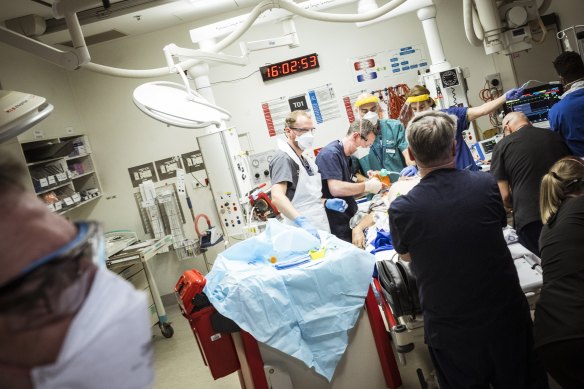Tens of thousands of Victorians are arriving at hospital emergency departments each year for non-urgent issues such as sprained ankles, minor aches and sore throats, which has prompted a renewed call from Premier Daniel Andrews for better and cheaper access to GPs.
New data from the Victorian government showed that in the last year, almost 38 per cent of the more than 1.7 million Victorians who attended emergency departments across the state were classified as either non-urgent category four or five presentations.

Emergency departments at Victorian hospitals have come under severe stress as demand keeps rising.Credit:Chris Hopkins
The figures prompted Andrews to again join forces with NSW Liberal Premier Dominic Perrottet to escalate their call for national health system reform. The two leaders warn declining bulk-billing rates and an increasing lack of access to GPs, was adding significant pressure to hospitals in the country’s most populous states.
“There is no more urgent priority for National Cabinet than reforming the primary care system,” Andrews said in a statement to The Age on Friday. “It is completely broken and failing patients every single day. We urgently need the federal government to put this at the top of the agenda.”
While senior emergency doctors back calls for immediate improvements to general practice, they say the states also have a role to play in fixing staffing shortages. They also urge caution on the data, and warn that research shows patients triaged as category four remain the most likely to die after arriving at hospital.
“Less urgency does not always mean less serious,” senior emergency physician Stephen Parnis said. “It is an utter myth that patients who are category four are not serious and that they can all go to their GP.”
Parnis said category four presentations can comprise abdominal pain, injuries from a fall, bone fractures and headaches or fever, of which the origins are unknown. National guidelines recommend category four patients be examined within 60 minutes. But often these patients now wait hours to be seen, increasing the risk of deterioration compared to more urgent patients, who are fast-tracked.
A patient triaged as category five generally has minor illnesses or symptoms that have lingered for more than a week, such as rashes and minor aches and pains. Between April and September this year almost 50,000 Victorians who went to emergency departments were triaged as category five.
Parnis said access to GPs continued to deteriorate across Victoria, and better community care would make an “enormous difference” to emergency departments.
“I worry that the federal government does not have fixing community health as a high enough priority,” he said. “Until there is proper co-ordination between state and federal governments we will continue to lurch from health crisis to crisis.”
Victoria’s emergency departments are also reporting increasing presentations in the most urgent categories, as the number of people presenting with life-threatening conditions has soared.
The most recent figures show almost 3700 patients who arrived in the state’s emergency departments were triaged as category one, up from 3400 in the previous quarter. The number of people triaged as category two – who need to have treatment within 10 minutes for an imminently life-threatening condition – was also on the rise, up to 74,000 in the last quarter alone, up from about 68,000 for the same period last year.
Victorian Health Minister Mary-Anne Thomas said there was an increase in presentations of people with deteriorating conditions, who could have avoided a trip to hospital had they seen their GP earlier.
“This can often lead to longer hospital stays, create a backlog in the system and impact the system’s ability to take on new patients,” Thomas said.
Earlier this month, The Age revealed doctors also feared that some smaller emergency departments, particularly in regional Victoria, may be forced to close temporarily because they cannot operate safely due to gaps in their rosters.
At Austin Health, 107 staff were off due to illness one day last week. Up to six emergency doctors in a single hospital are furloughed due to coronavirus infections each week. As coronavirus infections rise, daily statewide numbers for staff furloughing can reach up to 1600.
Dr Belinda Hibble, Victorian chair of the Australasian College of Emergency Medicine, said doctors welcomed any well-planned measures that increased access community-based care, such as GPs. However, Hibble warned that emergency departments were a “complex and fragmented health system” in need of urgent leadership and policy reform.
“EDs are always here for people seeking care,” Hibble said. “Many patients in lower triage categories are still very unwell and have been referred to EDs from primary care due to the complexity of their condition and, very often, the need for hospitalisation for these illnesses.”
Health Minister Mark Butler said the federal government’s “strengthening Medicare taskforce” was identifying the best ways to boost affordability and improve access through a $750 million fund.
“The former government froze the Medicare rebate for six years, ripping billions of dollars out of primary care and causing gap fees to skyrocket. The Albanese government is committed to investing in general practice and strengthening Medicare,” he said.
The Morning Edition newsletter is our guide to the day’s most important and interesting stories, analysis and insights. Sign up here.
https://news.google.com/__i/rss/rd/articles/CBMilQFodHRwczovL3d3dy50aGVhZ2UuY29tLmF1L3BvbGl0aWNzL3ZpY3RvcmlhL25vLW1vcmUtdXJnZW50LXByaW9yaXR5LWFuZHJld3MtZGVtYW5kcy1oZWFsdGgtc3lzdGVtLXJlZm9ybS1hcy1ob3NwaXRhbC1jYXNlcy1tb3VudC0yMDIyMTIyMi1wNWM4NzAuaHRtbNIBAA?oc=5
2022-12-23 08:24:53Z
CBMilQFodHRwczovL3d3dy50aGVhZ2UuY29tLmF1L3BvbGl0aWNzL3ZpY3RvcmlhL25vLW1vcmUtdXJnZW50LXByaW9yaXR5LWFuZHJld3MtZGVtYW5kcy1oZWFsdGgtc3lzdGVtLXJlZm9ybS1hcy1ob3NwaXRhbC1jYXNlcy1tb3VudC0yMDIyMTIyMi1wNWM4NzAuaHRtbNIBAA
Bagikan Berita Ini














0 Response to "‘No more urgent priority’: Andrews demands health system reform as hospital cases mount - The Age"
Post a Comment